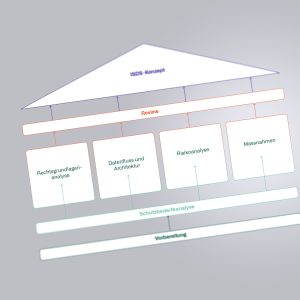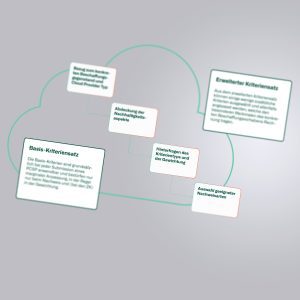Blog
Trend towards video room solutions for all meeting rooms
In the last year, the use of video conferencing and virtual meetings in companies has exploded, and the choice of video conferencing solutions has also increased in recent years. Which room system is now the right one for your company?
As the latest Gartner Magic Quadrant for Meeting Solutions from 12.10.2020 reveals, the vendors in the Leaders Quadrant are Microsoft, Cisco and Zoom. In this article we want to give you an overview of what the top 3 have to offer in terms of video room solutions and how they differ.
Historically, video conferencing solutions for meeting rooms were very expensive investments and the only way to run high quality audio-video (AV) meetings. In addition to the video conferencing systems, the entire backend infrastructure, sufficient network bandwidth and support/operations were needed to run the whole solution. Since the investments for the meeting room adaptations and the video solution quickly cost more than CHF 100,000 and had to be amortised over several years, it was not possible to be flexible in order to cover new needs.
There were a few large and a few small manufacturers in the market. With the purchase of Tandberg, Cisco secured the top spot for video/telepresence rooms for many years. The market situation only changed with the advent of modern software-based collaboration solutions that brought improved meeting quality to the workplace using USB cameras. In order to continue to offer video meeting rooms as an alternative and complement to the workplace, costs had to be significantly reduced and they had to be compatible with the new desktop collaboration solutions. Various AV vendors (e.g. Crestron, Logitech, Yeahlink, Poly) developed low-cost video conferencing systems in cooperation with the major software vendors (Microsoft, Zoom) that could be integrated into their collaboration solutions. Cisco also recognised the market opportunity and launched its own low-cost AV products in parallel. The trend among companies to equip small meeting rooms, so-called huddle rooms, with AV meeting rooms arose due to their cost-effectiveness.
Microsoft
Microsoft Teams Room (MTR) are meeting room solutions that offer a native Microsoft Teams experience with HD audio and video on Teams certified hardware from Microsoft and Microsoft partners (Microsoft Surface Hub, Crestron, Dell, HP, Lenovo, Logitech).
Similar to a PC, the operating system and app application is the same and differs mainly in hardware. The advantages of MTR are the native integration with MS Teams and the purchase price.
Besides the operating system solution with Windows, the one with Android was approved last year.
Microsoft's goal is that there is little to no difference between the Android (MTRoA) and Windows (MTRoW) platforms from an end-user perspective. Manufacturers such as Poly, Logitech or Yealink offer the new MTR appliances on Android in addition to the Windows solution. The Android appliance solution has the advantage that the management complexity is greatly reduced compared to the Windows solution.
Zoom
Similar to Microsoft, Zoom only provides the software for the meeting room. But unlike Microsoft, Zoom is a little more flexible in terms of hardware compatibility. The app works on Windows, Android and even Mac. It is recommended to pair the devices with Zoom Device Management (ZDM) to manage the devices from the Zoom Web Portal afterwards. ZDM is integrated in the standard Zoom licence and therefore generates no additional costs.
A major advantage of ZDM is that Windows devices registered with Zoom's Mobile Device Management (ZDM) service can be assigned Microsoft updates via the web interface. Administrators can create an update schedule that automatically installs Microsoft updates on registered devices.
AV products for Microsoft and Zoom
The strategy of the third-party AV providers is to offer systems that can be used for all major video conferencing solutions. Currently, six providers already offer meeting room solutions that can be used for MS Teams or Zoom. The meeting apps are pre-installed and the meeting app that is used in the company can be selected during setup. It is also possible to change the app later if the company decides to change the meeting conference solution. The video devices were mainly built around a Windows Compute solution. Originally, the Android appliances (Meeting Bar) were intended for small to medium sized rooms. However, it is now expected that Android solutions will also become available for large conference halls that can control the AV equipment using Network Device Interface (NDI).
The main differences between the solutions are the hardware structure, design and the composition of the peripherals. Third-party manufacturers that traditionally come from the PC environment only offer the compute unit (HP, Lenovo or Intel) or enter into a partnership with a traditional AV provider such as Crestron, Logitech, Poly or Yealink.
Technically, there is no problem mixing the certified products. However, we recommend using a product-homogeneous strategy.
Cisco
Cisco is the only one of the top 3 providers to offer not only the software but also the AV hardware from the same company. This of course has the advantage that you only have one manufacturer for the complete solution. It also enables homogeneous device management, depending on the setup from the Webex Cloud (WebEx Control Hub) or on-premise via the Cisco Call Manager.
A possible disadvantage is the lack of competition from third-party suppliers in the AV range and the possibly somewhat higher costs for procurement and maintenance.
In addition to Cisco's traditional large video meeting rooms, Cisco also offers smaller video room products. These new video solutions are similar to those from Zoom and Microsoft and represent the growing trend of adding video to smaller and medium-sized meeting rooms. Recently, Cisco has also started offering a Cloud Video Interoperability (CVI) solution to couple the Cisco video environment into Microsoft Teams. This allows Cisco video rooms to be included in Teams meetings without any additional effort for the user to create a meeting.

Blog
Hardware manufacturers for video room solutions in comparison
by Sven Matheja
Conclusion
Excellent room solutions can be realised with all 3 top providers (Cisco, Microsoft and Zoom). It is not a question of the functionality of the solutions for or against a solution, but it is the challenge to find the right solution for the company and the already existing IT landscape. We recommend developing a company-wide roadmap and strategy for the use of audio-video solutions before a patchwork quilt emerges. A strategy is also advisable because, with the exception of Cisco, it is now possible to mix or match the various solutions and to scale them very quickly thanks to cloud technology.
You should clarify the following points when purchasing a video meeting room:
- When evaluating a solution, do not focus on the individual components. Look at the whole. Include product variety, vendor roadmap, costs, platform management, partnerships, support and warranty in the evaluation criteria in addition to the technical analysis. If you already have a video conferencing solution, check whether it makes more sense to connect the existing environment to the existing conferencing solution with a cloud video interoperability solution.
- Does the provider offer a management solution or does it require further external tools to operate the system landscape?
- Who is responsible for the implementation and who will take over the operation? You have to decide whether you want to do this with internal resources (make) or external resources (buy).




